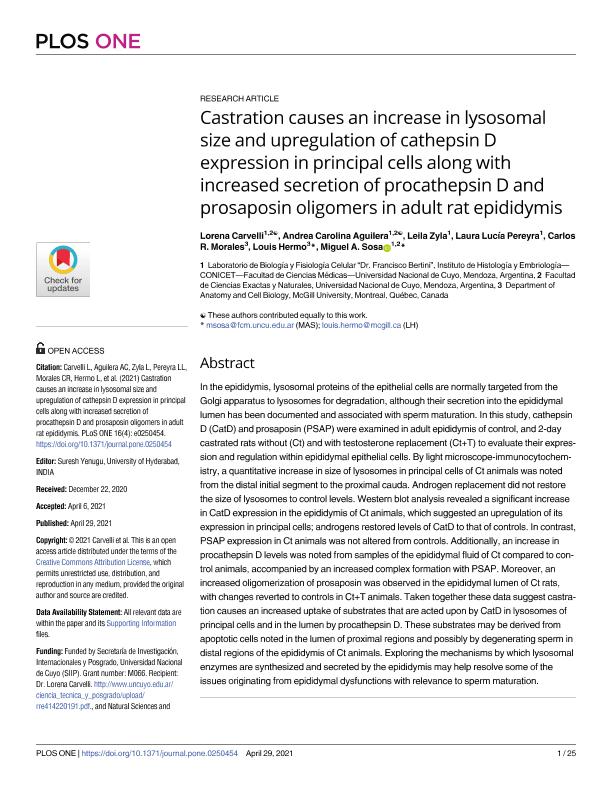Mostrar el registro sencillo del ítem
dc.contributor.author
Carvelli, Flavia Lorena

dc.contributor.author
Aguilera, Andrea Carolina

dc.contributor.author
Zyla, Leila Ester

dc.contributor.author
Pereyra, Laura Lucia

dc.contributor.author
Morales, Carlos R.
dc.contributor.author
Hermo, Louis
dc.contributor.author
Sosa Escudero, Miguel Angel

dc.date.available
2022-10-25T18:29:12Z
dc.date.issued
2021-04
dc.identifier.citation
Carvelli, Flavia Lorena; Aguilera, Andrea Carolina; Zyla, Leila Ester; Pereyra, Laura Lucia; Morales, Carlos R.; et al.; Castration causes an increase in lysosomal size and upregulation of cathepsin D expression in principal cells along with increased secretion of procathepsin D and prosaposin oligomers in adult rat epididymis; Public Library of Science; Plos One; 16; 4; 4-2021; 1-25
dc.identifier.issn
1932-6203
dc.identifier.uri
http://hdl.handle.net/11336/174825
dc.description.abstract
In the epididymis, lysosomal proteins of the epithelial cells are normally targeted from the Golgi apparatus to lysosomes for degradation, although their secretion into the epididymal lumen has been documented and associated with sperm maturation. In this study, cathepsin D (CatD) and prosaposin (PSAP) were examined in adult epididymis of control, and 2-day castrated rats without (Ct) and with testosterone replacement (Ct+T) to evaluate their expression and regulation within epididymal epithelial cells. By light microscope-immunocytochemistry, a quantitative increase in size of lysosomes in principal cells of Ct animals was noted from the distal initial segment to the proximal cauda. Androgen replacement did not restore the size of lysosomes to control levels. Western blot analysis revealed a significant increase in CatD expression in the epididymis of Ct animals, which suggested an upregulation of its expression in principal cells; androgens restored levels of CatD to that of controls. In contrast, PSAP expression in Ct animals was not altered from controls. Additionally, an increase in procathepsin D levels was noted from samples of the epididymal fluid of Ct compared to control animals, accompanied by an increased complex formation with PSAP. Moreover, an increased oligomerization of prosaposin was observed in the epididymal lumen of Ct rats, with changes reverted to controls in Ct+T animals. Taken together these data suggest castration causes an increased uptake of substrates that are acted upon by CatD in lysosomes of principal cells and in the lumen by procathepsin D. These substrates may be derived from apoptotic cells noted in the lumen of proximal regions and possibly by degenerating sperm in distal regions of the epididymis of Ct animals. Exploring the mechanisms by which lysosomal enzymes are synthesized and secreted by the epididymis may help resolve some of the issues originating from epididymal dysfunctions with relevance to sperm maturation.
dc.format
application/pdf
dc.language.iso
eng
dc.publisher
Public Library of Science

dc.rights
info:eu-repo/semantics/openAccess
dc.rights.uri
https://creativecommons.org/licenses/by/2.5/ar/
dc.subject
CATHEPSIN
dc.subject
CASTRATION
dc.subject
EPIDIDYMIS
dc.subject
LYSOSOME
dc.subject.classification
Bioquímica y Biología Molecular

dc.subject.classification
Medicina Básica

dc.subject.classification
CIENCIAS MÉDICAS Y DE LA SALUD

dc.title
Castration causes an increase in lysosomal size and upregulation of cathepsin D expression in principal cells along with increased secretion of procathepsin D and prosaposin oligomers in adult rat epididymis
dc.type
info:eu-repo/semantics/article
dc.type
info:ar-repo/semantics/artículo
dc.type
info:eu-repo/semantics/publishedVersion
dc.date.updated
2022-09-22T00:26:01Z
dc.journal.volume
16
dc.journal.number
4
dc.journal.pagination
1-25
dc.journal.pais
Estados Unidos

dc.journal.ciudad
San Francisco
dc.description.fil
Fil: Carvelli, Flavia Lorena. Consejo Nacional de Investigaciones Científicas y Técnicas. Centro Científico Tecnológico Conicet - Mendoza. Instituto de Histología y Embriología de Mendoza Dr. Mario H. Burgos. Universidad Nacional de Cuyo. Facultad de Ciencias Médicas. Instituto de Histología y Embriología de Mendoza Dr. Mario H. Burgos; Argentina. Universidad Nacional de Cuyo. Facultad de Ciencias Exactas y Naturales; Argentina
dc.description.fil
Fil: Aguilera, Andrea Carolina. Consejo Nacional de Investigaciones Científicas y Técnicas. Centro Científico Tecnológico Conicet - Mendoza. Instituto de Histología y Embriología de Mendoza Dr. Mario H. Burgos. Universidad Nacional de Cuyo. Facultad de Ciencias Médicas. Instituto de Histología y Embriología de Mendoza Dr. Mario H. Burgos; Argentina. Universidad Nacional de Cuyo. Facultad de Ciencias Exactas y Naturales; Argentina
dc.description.fil
Fil: Zyla, Leila Ester. Consejo Nacional de Investigaciones Científicas y Técnicas. Centro Científico Tecnológico Conicet - Mendoza. Instituto de Histología y Embriología de Mendoza Dr. Mario H. Burgos. Universidad Nacional de Cuyo. Facultad de Ciencias Médicas. Instituto de Histología y Embriología de Mendoza Dr. Mario H. Burgos; Argentina. Universidad Nacional de Cuyo. Facultad de Ciencias Exactas y Naturales; Argentina
dc.description.fil
Fil: Pereyra, Laura Lucia. Consejo Nacional de Investigaciones Científicas y Técnicas. Centro Científico Tecnológico Conicet - Mendoza. Instituto de Histología y Embriología de Mendoza Dr. Mario H. Burgos. Universidad Nacional de Cuyo. Facultad de Ciencias Médicas. Instituto de Histología y Embriología de Mendoza Dr. Mario H. Burgos; Argentina
dc.description.fil
Fil: Morales, Carlos R.. McGill University; Canadá
dc.description.fil
Fil: Hermo, Louis. McGill University; Canadá
dc.description.fil
Fil: Sosa Escudero, Miguel Angel. Consejo Nacional de Investigaciones Científicas y Técnicas. Centro Científico Tecnológico Conicet - Mendoza. Instituto de Histología y Embriología de Mendoza Dr. Mario H. Burgos. Universidad Nacional de Cuyo. Facultad de Ciencias Médicas. Instituto de Histología y Embriología de Mendoza Dr. Mario H. Burgos; Argentina. Universidad Nacional de Cuyo. Facultad de Ciencias Exactas y Naturales; Argentina
dc.journal.title
Plos One

dc.relation.alternativeid
info:eu-repo/semantics/altIdentifier/url/https://journals.plos.org/plosone/article?id=10.1371/journal.pone.0250454
dc.relation.alternativeid
info:eu-repo/semantics/altIdentifier/doi/http://dx.doi.org/10.1371/journal.pone.0250454
Archivos asociados
